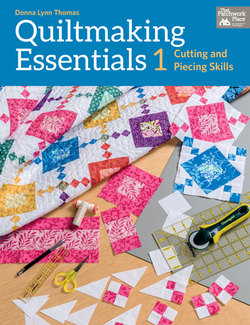Читать книгу Quiltmaking Essentials I - Donna Lynn Thomas - Страница 5
Introduction
ОглавлениеThis book is a reference manual about rotary cutting and machine-sewn patchwork, not appliqué, paper piecing, hand piecing, or foundation piecing. This volume (volume 1) covers basic rotary cutting, sewing, pressing, and block assembly. Volume 2 covers quilt-top assembly, sashes, borders, backings, and bindings.
Since we’re talking about basics, let’s begin at the beginning. What is a quilt? Well, it’s not a blanket! A blanket is a single-layer, woven bed covering. While quilts are also traditionally thought of as bed covers, they’re used extensively in home decor, decorating tables and walls, and are also seen more and more in museums as works of art.
Different from a blanket, a quilt is composed of two or three layers consisting most often of a patterned top, a batting (sometimes called a filling), and a backing (sometimes called a lining). The three layers are stitched together with decorative quilting stitches. This stitching is what gives a quilt its name, while the three layers give it the warmth. A two-layer summer quilt omits the middle layer and is often found in warmer climates.
Quilt tops can be constructed in a number of ways. A whole-cloth quilt is just what its name implies—one large piece of fabric, either plain or printed, that serves as the top. The decorative quilting provides the design.
Patchwork tops come in two forms: pieced or appliquéd. Appliqué is the process of cutting pieces of fabric and applying them to a larger whole to create a design. Broderie perse is one form of appliqué in which motifs are cut from printed fabrics and then applied to a whole cloth to form a design. Most often today, though, pieces are appliquéd to smaller blocks, both plain and pieced, that are then sewn together to make the quilt top.
Appliquéd block
Piecing consists of sewing smaller pieces of fabric together side by side to form a greater whole. Most often, pieces are sewn into blocks of specific patterns that are then joined to make the quilt top. Sometimes pieces are sewn together into one overall design.
Pieces sewn together to form a block
Pieces sewn together to form an overall design
You’ll find many references to precision in this book. Precision is not about pleasing the quilt police. It has everything to do with mastering skills so you can enjoy the process of making your beautiful quilts without frustration, mistakes, ripping, easing, and fudging to make things work. Remember, even Van Gogh had to learn how to hold a brush and mix paints before he could create his masterpieces. If you master precision skills so they become second nature, frustration-free sewing will be like breathing—you won’t even think about it.
To help you learn the finer points of quiltmaking, you’ll find four different types of tip boxes sprinkled throughout this book:
? Did You Know? tips explain words, concepts, or background information in a bit more depth.
Blue-Ribbon Skills tips offer suggestions for fine-tuning a particular skill.
! Problem Solving tips warn you of or help you out of a potential “oops” and suggest how to fix or prevent a problem.
# The Numbers Box tip, everyone’s favorite, will help you with—yikes!—math or numbers.
